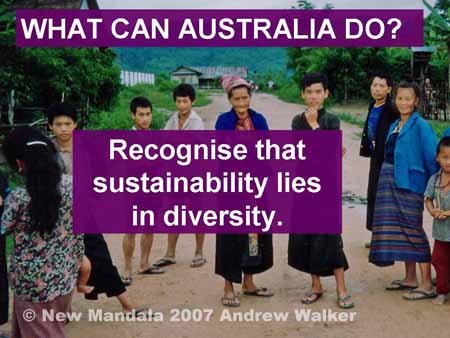Late last month I attended the conference on A Greater Mekong: Poverty, Integration and Development at the University of Sydney. The conference was organised by the Australian Mekong Resource Centre and AusAID and hosted a range of bureucratic, academic and activist presentations on the state of Mekong region development (a list of papers is available here). The conference was also the occasion for the launch of AusAID’s new Greater Mekong Subregion Strategy to Promote Integration and Cooperation. It was launched by Greg Hunt, Parliamentary Secretary to the Minister for Foreign Affiars. (Greg was introduced, among various other achievements, as having been an advisor to Alexander Downer during his brief stint as Opposition Leader – that’s something I’d be leaving off my CV!) The centre-piece of the strategy is the provision of infrastructure to support the Asian Development Bank’s Greater Mekong Subregion initiative.
For a number of observers, myself included, AusAID’s enthusiastic endorsement of the ADB infrastructure driven scheme is puzzling and disturbing, particularly given ADB’s very poor record in the management of the social and environmental impacts of its projects. In my presentation to the conference I made reference to the AusAID strategy. I had been asked to speak to the conference about the role of civil society in river basin management and argued that genuinely enhancing participation required both an appreciation of the political context and openness to alternative forms of environmental knowledge (my full presentation is here). My closing comments went something like this:
So, what can Australia do to promote civil society engagement in the Mekong? Here I will provide a one minute review of AusAID’s Greater Mekong Strategy and the “coalition of the willing” approach it takes towards Mekong region development.
My primary concern about this strategy is its failure to realise that sustainability lies in diversity. Rather than signing up to one particular development package with one particular approach to civil society engagement, Australia should be using its ingenuity and imagination to promote diverse, varied, experimental and even risky approaches to enhancing meaningful participation. There are many ways in which Australia could support civil society engagement in the region but in AusAID’s Mekong Strategy the issue barely rates a mention. This is a Strategy which seems to place excessive faith in existing institutional structures for development (lead by the ADB). It is disengaged from the politics of Mekong basin development and seemingly unaware that alternative forms of knowledge may provide profoundly useful ingishts into the challenges of poverty alleviation in the region. The Strategy seems to score well according to the ADB’s three-Cs of connectivity, competitiveness and community. But its performance in terms of a fourth C – creativity – is rather poor.
Unfortunately I had to leave the conference before the end of the first day. So if any other New Mandala readers would like to report on other aspects of the conference or comment further on AusAID’s strategy please post your comments here or draft a guest post.
 Facebook
Facebook  Twitter
Twitter  Soundcloud
Soundcloud  Youtube
Youtube  Rss
Rss 